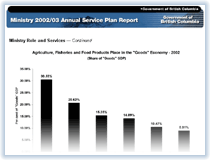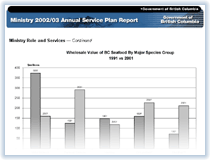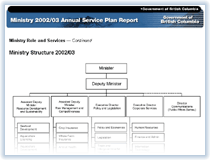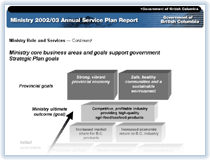 |
|
Ministry Role and ServicesMinistry Vision, Mission and ValuesVisionA competitive and profitable industry providing safe, high quality food for consumers and export markets. MissionProvide the business climate for a competitive market-responsive agri-food and fisheries sector, and safeguard the quality of British Columbia's agri-food products for consumers. ValuesThe following values outline the fundamental beliefs of the ministry and describe how the organization and its employees interact with clients and each other. The ministry strives to conduct its business in a manner that is: 1. Fair and equitable — Building and maintaining among ministry personnel an effective spirit of teamwork and cooperation based on trust, integrity, flexibility, innovation, social equity, and equality of opportunity. 2. Responsible and accountable — emphasizing responsible use of government resources and transparency in accounting for the use of those resources. 3. Service-oriented — responding to the needs of the public, agriculture and fisheries sector groups, communities and staff in a timely and courteous manner. 4. Partnership-building — promoting teamwork, good working relationships, and effective partnerships with, and co-operation among, all orders of government, First Nations, agriculture and fisheries sector groups and communities. Ministry OverviewThe ministry's role is to provide a business climate that favors a competitive sector and sustainable economic development. The business climate is influenced by various challenges and opportunities. The ministry performs its role by setting strategies that address these challenges and opportunities through six core business areas identified in the government's Core Services Review undertaken in 2001. These core functions are food safety and quality, environmental sustainability, fisheries and aquaculture management, risk management, industry competitiveness and corporate services. Each of these functions as well as the service details within each core function are discussed later in this report. Ministry Operating ContextEnvironmental ScanAgriculture, food and fisheries — an important part of the overall provincial economy Place in the provincial economy The agriculture, food and fish sectors are significant to the provincial economy. In 2002 these sectors contributed about $3.5 billion to gross domestic product (GDP) or roughly 11% of total GDP contributed by the goods sector. These sectors combined were a major employer with over 60,000 persons employed at the primary and manufacturing levels. When food distribution, retailing and food service are added there are over 270,000 persons employed throughout the food chain, or one in seven jobs in the employed labor force. Agriculture and Food Sectors Trends in key economic measures Data over the last five years show a mixed economic performance picture for the sectors as a whole.
Compared to the previous five-year average, 2002 agriculture product sales at $2.2 billion were up 13.7% while food and beverage sales at $5.3 billion were up 8.2%. Exports of agricultural and food products (excluding fish) which totalled $1.5 billion were up 21% from the previous five-year average. Employment in agriculture and food (excluding wild fisheries) at 57,000 was up a modest 2%, while total investment actually fell by 16.6% at the primary level (combined agriculture, aquaculture and wild fisheries) and by 3.4% at the processing level. The investment declines were due to the reduction of smaller farming operations in key commodity sectors (livestock and fruit and vegetable) and the closure or rationalization of production lines in certain food processing industries (meat slaughtering, seafood processing). Fisheries and Aquaculture Sector Key Trends In the last ten years, the seafood industry has been changing and evolving. The value of salmon and herring wild harvest fisheries has declined while the value of shellfish and groundfish has increased. Farmed fish has increased output and is now the most significant Canadian fish export. Total fish exports reached $1 billion in 2002, up 16% over their previous five-year average. The wholesale value of all B.C. seafood production has remained stable at about $1 billion in the last five years.
Challenges, Opportunities and Risk AnalysisThere are a number of challenges to the sectors from domestic and global sources, but also opportunities. Both affect overall competitiveness. Government's goal is to help the industry respond effectively to the challenges and available opportunities. The government is focusing on an outcome-based competitiveness strategy of helping firms profitably gain and maintain their market share. Government is doing this by removing obstacles, reducing regulations, promoting environmental best practices and trade. Challenges internal to B.C. Barriers to growth — Progress was made this year to reduce the regulatory burden on the agriculture and aquaculture sectors. Yet, regulations and somewhat inflexible labour standards remain challenges to be overcome in enhancing industry competitiveness in the future. Resource constraints — Loss of rangeland grazing, forest encroachment, impact of weeds, access to water and competition with other land uses limits food production capacity. Intergovernmental issues — Agriculture is a joint jurisdiction under the Canadian constitution. During 2002, the provincial government worked with the federal government on a major new funding initiative — the Agricultural Policy Framework (APF) to replace an expiring federal/provincial government program that provided funds mainly for agricultural risk management. B.C.'s challenge is to manage provincial government budget pressures against its expected funding contribution (60/40 federal/provincial) to the new program. The jurisdiction over aquaculture and fisheries is also complex and a blend of federal-provincial interests resulting in management and policy challenges. Diversified production — Agriculture in B.C. is highly diversified. While this is positive in spreading opportunities and reducing risk, it also stretches the capacity of some smaller farm organizations to participate in, and collectively manage, their own development. Fisheries capacity — Fluctuations in fisheries species abundance, restricted access to fisheries and conflicts over how resources are used continue to affect the fisheries sector. There is also some lack of capacity including high turnover in skilled labour in the processing and harvesting sectors which affects the industry's ability to move into more diversified and higher value-added products. Challenges externally and globally Competition from other exporters — The open market for most agriculture, food and fish products makes the B.C. industry vulnerable to significant international competitition, especially from countries with lower production costs beginning to export into some of B.C.'s export markets. Appreciating Canadian dollar — The agriculture sector exports one-third of its production. The sharp rise in the value of the Canadian dollar since Fall 2002 makes British Columbia's exports more expensive in the United States while competing American imports become less expensive in Canadian markets. Excessive subsidy payments — Exceptionally generous government subsidy payments to farmers, notably in Europe and the U.S., tend to lower commodity prices in world markets which hurt British Columbia's producers' ability to compete on an equal basis. The international community is currently trying to address trade disparities through multilateral trade negotiations under the World Trade Organization (WTO), as well as regionally, such as the Free Trade Area of the Americas negotiations. Neither of these negotiations is scheduled for completion before 2005. International trade rules — There are uncertainties and complexities in current international trade rules that may result in marketing challenges for B.C. The recent World Trade Organization ruling on Canadian dairy export subsidies determined that domestic support measures can also be export subsidies. As a result of this, B.C.'s exports of dairy products will decrease. As well, after December 31, 2003, without a new WTO agriculture agreement, there could be an escalation of disputes over the impact of agricultural subsidies in third country markets; i.e., countries in which two other countries export/compete. There are also other trade uncertainties from technical measures taken by other governments, such as mandatory "country of origin" labeling in the U.S. scheduled for September 30, 2004, and new U.S. border measures designed to guard against bioterrorism. Fisheries challenges — Global markets set food safety standards, and dictate prices and demand for B.C. fisheries and aquaculture products. B.C. producers also have high production costs which affect competitiveness. The public continues to demand safe, high quality and diverse food products while raising environmental and conservation issues. In combination, these lead to shifts in purchasing behavior, lifestyle choices and therefore how fisheries are managed. Opportunities While local and global challenges need to be managed effectively, there are a number of opportunities that can enable the sectors to reach their full potential. Heartlands Economic Strategy — The B.C. government's Heartlands Economic Strategy brings a focus on the contribution of the agriculture, food and fish sectors to developing local community and regional economies. Agricultural Policy Framework — There are major opportunities arising from B.C. participation in the federal/provincial Agricultural Policy Framework (APF). It could bring more than $200 million of new federal funding to B.C. over the next five years. Implementing the new framework will also enable the B.C. industry to maximize new international market opportunities for high-quality, safe, environment-friendly products. New trade agreements — There are favorable potential agricultural outcomes from on-going multilateral trade negotiations under the auspices of the World Trade Organization (WTO), as well as regionally, such as the Free Trade Area of the Americas negotiations. These aim to open new market oportunities and level the competitive playing field for efficient producers and processors. Aquaculture strategic alliance/diversification — Developing a stronger strategic alliance with the federal government on fisheries management in B.C. will be important to diversifying aquaculture products and technologies resulting in a more innovative, market-focused seafood industry. Niche markets — The broad multicultural population base in B.C. combined with the diverse productive capacity of the sectors can create niche market opportunities. Internal Risk Analysis Ministry resources — Effective human resource planning is one of the key strategies to meeting challenges. In addition, examining new opportunities and partnerships for effective service delivery under an environment of budget and staffing constraints is a strategy to meet these challenges. This can be done through financial partnerships and/or coordinated initiatives and action plans with the federal government, with other provincial ministries addressing agricultural and fish issues, and with farm organizations and others within the industry itself as they work to strengthen their own development. Maximizing such leverage and coordination of activities is already a key part of the ministry's overall strategy. This aspect is likely to grow in emphasis and importance in the years ahead and is a key attribute in effectively managing overall risk.
Strategic Shifts and Significant Changes in Policy DirectionThe ministry is on target with making the seven strategic shifts outlined in the core review process. They are:
Update on New Era CommitmentsKey new era commitments for this ministry were outlined in the Premier's letter of June 25, 2001 to the Minister of Agriculture, Food and Fisheries. Progress on those specific commitments is highlighted below.
Ministry Structure 2002/03
Core Business AreasThe ministry's 2002/03 core business areas are: 1. Food safety and quality (including animal, plant and fish health) 2. Environmental sustainability and resource development 3. Fisheries and aquaculture management 4. Risk management 5. Industry competitiveness 6. Corporate Services 1. Food safety and quality (including animal, plant and fish health)
2. Environmental sustainability and resource development
3. Fisheries and aquaculture management
4. Risk management
5. Industry competitiveness
6. Corporate Services
Consistency with Government Strategic Plan Each core business area indicates specific linkages with the Provincial Government's "A New Era for British Columbia". The core business area descriptions also describe linkages to the Premier's letter to the Minister where applicable. Specifically, the government's broad goals are:
All of the ministry's core business areas address the first goal of developing a stronger economy. Specific core business areas also address one of the other goals directly e.g., food quality and safety, and environmental sustainability and resource development, would address the last goal. All of the core business areas address each of the government's goals to some degree. [see illustration below] Ministry core business areas and goals support government Strategic Plan goals
|
|||||||||||||||||||||||||||||||||||||||||||||||||||||||||||||||||||||||||||||||||||||||||||||||||||||||||||||||||||||||||||||||||||||||||
|
||||||||||||||||||||||||||||||||||||||||||||||||||||||||||||||||||||||||||||||||||||||||||||||||||||||||||||||||||||||||||||||||||||||||||




